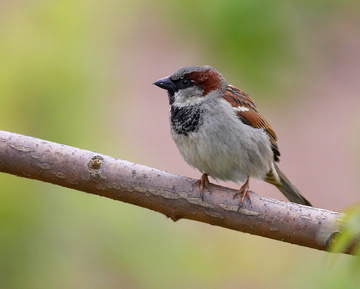
House Sparrow © Richard Steel
The Atlas map reveals that House Sparrow is no longer in the top ten of widely distributed breeding species in the county, but the population figures show that it is our most abundant bird. This apparent paradox is easily explained: as a social / colonial bird, it is not found everywhere but there are often large concentrations where they do occur.
Their population has declined nationally and they are now (from 2005) on the Red List of species of conservation concern. The population indices showed a 40% drop in breeding numbers in England during the period of our First Atlas (1978-84) and there has been a further 45% drop in twenty years since then (1984-2004). However, these data are mainly from rural areas, almost certainly driven by a fall in overwinter survival as has been experienced by many farmland seed-eaters, and their decline has been greatest in eastern and south-eastern England. House Sparrow density in many rural towns (Summers-Smith 2003), and in some urban and suburban areas, appears not to have changed much for many years although there are well-publicised dramatic collapses in populations in the centres of some big cities. There are several research projects, and much speculation, on the reasons for this, including loss of nest sites from tidier building maintenance, increases in cat predation, pollution from unleaded petrol and the over-use of pesticides; but firm results are still awaited.
Apart from odd tetrads of under-recording in the First Atlas or this survey, the species has been lost from the far west and far east of our area. House Sparrows do not now breed on Hilbre, where their fortunes have previously been shown to follow the practices of different wardens in keeping chickens, or not (Craggs 1978). The most noticeable area of loss in the last twenty years is the eastern hills. House Sparrows are now missing above approximately the 350m contour mark; a similar distribution has been observed in the tetrad atlases of Northumbria, Lancashire and North Merseyside, and Cumbria. It is probably not a simple effect of altitude, however, and is likely to be the change in agricultural practice and habitation, and possibly rainfall, as the weaver family, including sparrows, generally inhabit arid lands. There is no obvious reason for the change in the last twenty years, which has occurred un-remarked in Bird Reports, but it does mirror that of Starling.
As well as preferring to be with other sparrows, House Sparrows are seldom found far from people, and 80% of the habitat codes recorded in this survey were category ‘F’ – human sites, with 17% being farmland. There has been an interesting change in birdwatchers’ attitude to the species, it having gone from being ignored, often disliked, to becoming a topic of conversation and often a matter of some pride for those of us who have them living near to us.
The BTO analysis estimated a Cheshire and Wirral breeding population of 211,490 (160,420-262,550) individuals, an average of about 42 pairs/km2 across the whole county. Thus, Cheshire and Wirral holds about 2.0% of the UK population; with 1% of the land area of the UK, we have more than our proportionate share of the species. Despite their traditional easterly distribution, perhaps the comparatively benign intensification of our pastoral agriculture has been relatively favourable for sparrows, compared to their fate in the arable counties.
A 2001 survey in urban North Merseyside (White 2002) found amazing variations in the density of breeding House Sparrows, from none to 192 pairs/km2, with an average of 62 pairs/km2. They had almost abandoned central Liverpool and St Helens, but no correlation could be deduced with any geographical or habitat features examined. A similar survey in Cheshire and Wirral would make an admirable project for CAWOS members.
Sponsored by Peter Royle

